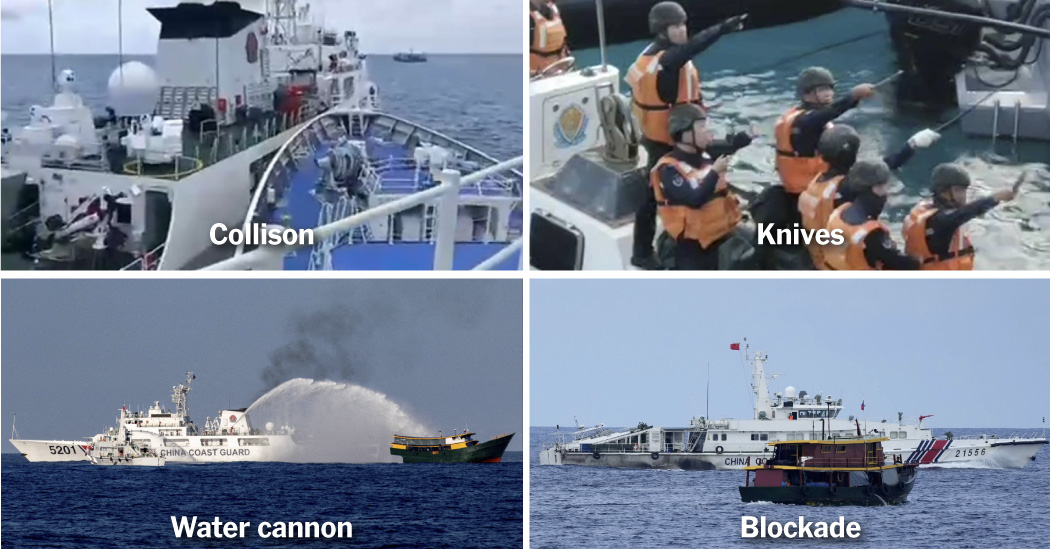Chinese coast guard ships have been swamped and collided with Philippine boats. They doused Philippine ships with powerful water cannons. Chinese crews have slashed inflatable craft, sounded sirens and flashed powerful lasers at Philippine troops.
As China seeks to dominate the South China Sea, it is increasingly willing to use force to oust the Philippines, a treaty ally of the United States. In recent months, China’s tactics have damaged Philippine boats and injured personnel, raising fears of a showdown between the superpowers in the strategic waterway.
A new flashpoint
For months, the latest target of China’s power play was a Philippine coast guard ship, the Teresa Magbanua. The above video was taken by the crew of that ship when it was struck by a Chinese Coast Guard ship late last month.
The episode was one of four confrontations between the two countries’ ships in just two weeks. The encounters not only became more frequent, but also took place in a new location: Sabina Shoal, a resource-rich atoll close to the Philippine mainland.
The two countries have faced off in recent months near another atoll in the disputed Spratly Islands, the Second Thomas Shoal, where Chinese ships regularly harass Philippine boats trying to resupply sailors stationed on a beached warship. Now their feud has expanded.
These are the places where China has confronted the Philippines since 2023.
Note: Incident locations are approximate based on locations broadcast by the Philippine and Chinese Coast Guard vessels. Other tools include lasers, knives, axes and stones.
The Philippines wants to control Sabina Shoal, an unoccupied atoll within the exclusive economic zone. Located just 80 miles west of the Philippine province of Palawan and more than 600 miles from China, Sabina Shoal is close to an area rich in oil resources and on routes that Manila considers crucial for trade and security.
“A hostile China could strangle our maritime trade with the rest of Asia and most of the world from Sabina Shoal,” said Jay Batongbacal, a maritime security expert at the University of the Philippines. Sabina Shoal would be “a good base for ships that will disrupt Philippine maritime activities,” he said.
Manila anchored the Teresa Magbanua, one of its largest coast guard ships, at the Sabina Shoal in April to try to deter China from what the Philippines sees as attempts to build an island there.
The Philippine Coast Guard has pointed to piles of crushed and dead corals apparently dumped on the shoals as signs of Chinese land reclamation underway. China has denied the accusation. But the construction and fortification of artificial islands is a key part of how China has asserted its claims over disputed waters hundreds of miles offshore.
China, which claims almost the entire South China Sea, says its tactics are necessary to defend its sovereignty. Beijing has rejected a 2016 international tribunal ruling that China’s sweeping claim to the waters had no legal basis.
China accused the Philippines of permanently occupying Sabina Shoal by parking the coast guard ship on it, just as it had grounded the warship at Second Thomas Shoal. Beijing even tugboats sent to Sabina Shoal, which some read as a threat to tow the Philippine ship away.
China has not resorted to weapons. Instead, it uses what military theorists call gray zone tactics, aggressive moves that are incapable of provoking all-out war. This includes imposing blockades, shooting water cannons and sailing dangerously close.
But these moves can still cause damage: for example, the recent collision between Chinese and Philippine boats left a one-meter hole in the Teresa Magbanua, as well as another Philippine ship.
Damage to the Teresa Magbanua
Philippine Coast Guard via Associated Press
“If the Philippines insists on occupying more shoals, China will have no choice but to use all available measures,” said Hu Bo, director of the South China Sea Strategic Situation Probing Initiative, a Beijing-based research group. “There is no limit.”
On Sunday, after months of pressure from China, the Philippines said the Teresa Magbanua had returned to Palawan port. The Philippine statement sought to make the move following the completion of the boat’s mission.
But it nodded to the challenges of continuing to face a Chinese blockade that prevented the ship from being resupplied, saying the crew had “survived on reduced daily provisions” and that some required medical care.
The Philippines said the ship suffered structural damage from the Chinese coast guard’s assessment, but indicated the boat would return after repairs.
Tensions are increasing
President Ferdinand R. Marcos Jr. of the Philippines has taken a stronger approach against China than his predecessor. He has strengthened the country’s alliance with the United States and invited journalists to take part in resupply missions at sea to highlight China’s actions.
China has called the United States “the biggest troublemaker fueling unrest in the South China Sea.” Mr Hu, the expert in Beijing, said China has been forced to use tougher tactics because diplomacy with the Marcos government has failed.
Now that both sides are digging in, they are getting into conflict with each other more often and aggressively.
Confrontations between China and the Philippines
In one confrontation in June, the Chinese coast guard used axes, tear gas and knives to harass Filipino troops on a supply mission to the Second Thomas Shoal. Chinese sailors have punctured Philippine military boats and seized their equipment, including weapons.
Eight Filipino soldiers were injured, one of whom lost a finger. The Philippine military called it the “most aggressive” Chinese action in recent history.
Source: Armed Forces of the Philippines via Facebook
That June 17 episode made it clear that tensions needed to be reduced. The two sides briefly reached a “tentative agreement” on the Second Thomas Shoal, and the Philippines was able to conduct a resupply mission in late July. But officials from both countries have disputed the details of the agreement, raising questions about how long it will last.
“China’s overarching strategy is to dominate the South China Sea. We should not expect the de-escalation to continue,” said Rommel Ong, a professor at the Ateneo School of Government in Manila and a retired rear admiral in the Philippine Navy. “Unless they achieve that goal, their coercive measures will wax and wane depending on the situation.”
Since October, China’s coast guard has used water cannons against Philippine ships more times than it has probably ever done in the long-running dispute. Collisions are also becoming more common.
In recent confrontations, China has routinely used water cannons.
Sources: Armed Forces of the Philippines; Philippine Coast Guard; Chinese Coast Guard; Reuters; Storyful
Whenever the Philippines tried to sail to disputed atolls, they were quickly confronted by Chinese coast guard ships, maritime militias and navy.
Some Chinese ships shadow the Philippine boats. Others crossed their path. The ships swarm around the Philippine ships and form a strong blockade.
For example, Chinese ships set up a blockade.
Note: Tracks show positions over the last six hours. Location data is not available locally for all ships. Times shown in local Manila time.
China, which has the world’s largest navy by number of ships, has deployed more boats to these disputed waters in the past year than before. The Philippines sends an average of a few ships on their supply missions, which have remained largely unchanged.
Mr. Hu, the China expert, said China’s show of force in numbers is intended to deter the Philippines without resorting to lethal force. “If China only sends a small number of boats to stop the Philippines, they may have to use weapons,” he said.
China has sent more ships to harass Philippine supply missions.
Source: Center for Strategic and International Studies (CSIS)
Note: Records show vessel counts were made during resupply efforts to Second Thomas Shoal.
From August 27 to September 2, a period of one week, the Philippine military tracked 203 Chinese ships in disputed areas in the South China Sea – the highest number recorded this year.
Tensions have risen at a time when the militaries of China and the United States have had limited contact. On Tuesday, the commander of the U.S. Indo-Pacific Command held a rare videoconference with Gen. Wu Yanan, the commander of the People’s Liberation Army’s Southern Theater Command, which oversees the South China Sea. The United States said such calls “help reduce the risk of misperception or miscalculation.”
During the conversation, Ad said. Samuel Paparo urged China to reconsider “the use of dangerous, coercive and potentially escalatory tactics” in the South China Sea. China, in its own statement on the call, said only that the two sides had an in-depth exchange of views.
But on Thursday, Lt. Gen. He Lei, former vice president of the People’s Liberation Army Academy of Military Sciences, took a more aggressive tone.
“If the United States insists on being a conspirator in pushing others to be on the front lines to confront China, or if it has no choice but to challenge us itself,” said he told reporters at a security forum in Beijing, “the United States The Chinese people and the People’s Liberation Army will never hesitate.”
Chinese flagged boats anchored at Sabina Shoal.
Jes Aznar for The New York Times





















